A City in L.A. County with a $55,000 Median Price? The Housing Market in Los Angeles County: Looking Deep into the Home Sales Data for 88 Cities. Lower Priced Areas Taking Brunt of Price Declines but Medium to Higher Priced Areas Stubborn in Price Movements.
The housing market in Southern California appears to be sitting in the eye of the hurricane or as some are now thinking, has withered the brunt of the tempest. In recent days the amount of people looking to buy because they think this is the bottom is astounding. Part of this has to do with the Federal Reserve deciding to buy treasuries and keeping mortgage rates at record lows. Another reason is many are thinking that the U.S. Treasury, Federal Reserve, and FDIC Private-Public Investment Program is somehow going to free up resources to get the markets moving again. I think that is partly the problem with how the current economic situation is being framed in regards to the housing market. Homes are selling. Credit is still available. It just isn’t as accessible as it was during the peak bubble years. This is a relative shock since we went from a situation where anyone could get a mortgage to a situation where we are now using traditional rubrics for giving mortgages to borrowers.
Many articles both on mainstream outlets and blogs have highlighted that much of the drag on the median price for California has occurred because of lower priced foreclosed homes being the bulk of the market. This is true. However, the real shift is more subtle and explains the situation better. That is, there are multiple parts moving at the same time that have brought the market down to reality quickly:
–Pay Option ARMs and Alt-A gone from market
-Income verification and stricter loan guidelines
-Lower priced homes selling with government backed mortgages
-Higher priced home sales collapsing
These are four major factors influencing the current market. Those waiting on the sidelines have two perspectives. One is that the bottom is now in places and with low mortgage rates, the time to buy is now. The other perspective is focusing on more prime properties and expects that price drops will only move up the property ladder affecting the entire market. I am of the opinion that we have yet to see the bottom in middle to higher priced homes. However, certain lower priced areas may be seeing signs of a bottom. I have gathered the March 2009 sales data for L.A. County and by looking at the entire market, we get a better idea of what is happening:
When we start looking at the data like this, we have a much better idea of what is occurring. 80% of all homes sold in L.A. County for March of 2009 fell below the $499,000 mark. 68% of all homes sold were under $399,000. This gives us a better sense of how the market is playing out.
Yet this is something that we already know given the median price for L.A. County is $299,000. What I also want to point out in the data above is the year over year price drops. This is where the real divergence occurs. What you’ll notice is that the top of the market, homes over $2 million have fallen by 30 percent. Yet, once we start looking at home between $1 million and $1.9 million prices are actually up! Homes between $400,000 and $999,000 actually fell only by 8 percent to 19 percent. Compare this to the lower ranges where we see some areas falling by 57 percent! And most of the sales are occurring on the lower range so that is why the median is falling. But that is also where most people are buying. So to dismiss that as an anomaly is a big mistake. The bulk of homes sold are occurring under the $400,000 mark. Yet most people that read this blog and are looking to buy in higher priced areas, (FYI, over 50 percent of readers on this blog come from households with $100,000 yearly incomes) many are looking at homes in the $400k+ category yet want to have those lower prices. That is the current stalemate. Higher priced home sales are plummeting while many wait it out. The lower range of the market is still moving however.
Now this returns us back to the crux of the current issue. Will those upper ranges start seeing more dramatic drops in home prices? I tend to think that we will start seeing drops here. Keep in mind that lower range is moving because many of these buyers had very little room to deal with an economic crash and many simply lost their homes having them taken back by banks. Yet many in the middle to upper range that bought during the bubble took on exotic loans like Pay Option ARMs that are now recasting. Many of these people are employed and can make the lower payment but their only out is selling to someone that is willing to pay that bubble price. From the number of sales we are seeing, buyers are not willing (or can’t qualify) to buy those homes. So the upper range of the market sits patiently waiting for someone to blink. Here is a look at the amount of sales in various price ranges:
Home sales are clustering around a certain price range. And let me highlight that high priced home sales are always going to be lower just by definition but right now the main question is how high will the bubble regress? Which ranges will it impact? That is what we are waiting to see.
And sometimes it helps to go back to the pre-bubble days just for a sense of perspective. Let us compare a few counties in Southern California with their 1999 prices:
This I think can really help us figure out whether we are seeing a bottom or not. As we have pointed out above, the brunt of California’s price declines have occurred because of lower priced homes. This applies to Los Angeles County.  In Southern California, the most devastated counties are San Bernardino and Riverside. These are also the counties that have seen the biggest jump in sales. So let us look at data above from December of 1999 to see how much more expensive was L.A. County than the Inland Empire.
Back in 1999, L.A. County had a median price that was 27 percent higher than that of San Bernardino and 18 percent higher than Riverside. For 2009, that ratio is drastically different. L.A. County is now 48 percent more expensive than San Bernardino and 36 percent more expensive than Riverside. Let us just assume for argument sake that San Bernardino and Riverside are now closer to their market bottoms. And let us assume those ratios of 1999 pre-bubble days come back. What should the median price of L.A. be? We are looking at a median price range of $194,000 or $224,200 depending on which ratio we use. Meaning, the median price of L.A. County is still too high by 20 percent. Now again, this is assuming we are at the bottom and I think that there are many reasons why California won’t see a bottom until 2011. Let us take a look at how those lower priced homes are looking at for L.A. County:
Take a look at Palmdale! A drop of 78 percent and a current median price of $55,000! At these numbers, many investors are probably snatching up these properties as rentals. Take a look at Lancaster as well. These are sub $100,000 areas of Los Angeles County. A few years ago if you would have told someone we would be talking about 5 digit median prices they would have thought you were insane. When you actually start putting the cities, sales, and median prices together the picture becomes perfectly clear. Many of the obvious bubble areas are correcting viciously. Yet how many other higher priced areas are still in denial? That is what we will be looking at. For example, let us take a look at that $500 – $599k range:
This price range is where I have been getting the most e-mails that go something like, “if California is down by 50%, why is my area barely down a few percentage points?” Well look at the chart above. Some of these areas are actually positive on a year over year basis! Yet the number of sales is rather low so it is hard to tell where the trend is heading. This is the range that we need to keep our eye on. And here is an interesting fact. Assume these homes drop and start selling in the $400 to $499k range but this drop spurs a larger number of buyers. The overall median for the county will go up! That is why the median price cannot be focused on by itself but needs to be taken into context. That is why when the bubble was raging and we were seeing all those homes in Compton or Pomona going for $500,000 we knew the median price was entirely distorted. This also is the case on the downside.
So what can we expect for L.A. County? Expect to see the $500 to $999k range take a hit this year but don’t expect gigantic shifts in the overall county median. It will go lower but if you see slight movements, just understand that this is what is occurring. With an unemployment rate of 10.5% (2 million workers unemployed) and property values taking a hit, California and especially regions like L.A. County have yet to see the bottom.
 Did You Enjoy The Post? Subscribe to Dr. Housing Bubble’s Blog to get updated housing commentary, analysis, and information.
Did You Enjoy The Post? Subscribe to Dr. Housing Bubble’s Blog to get updated housing commentary, analysis, and information.

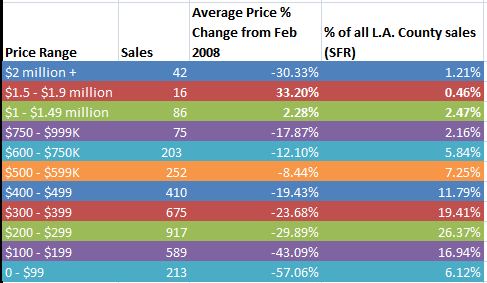
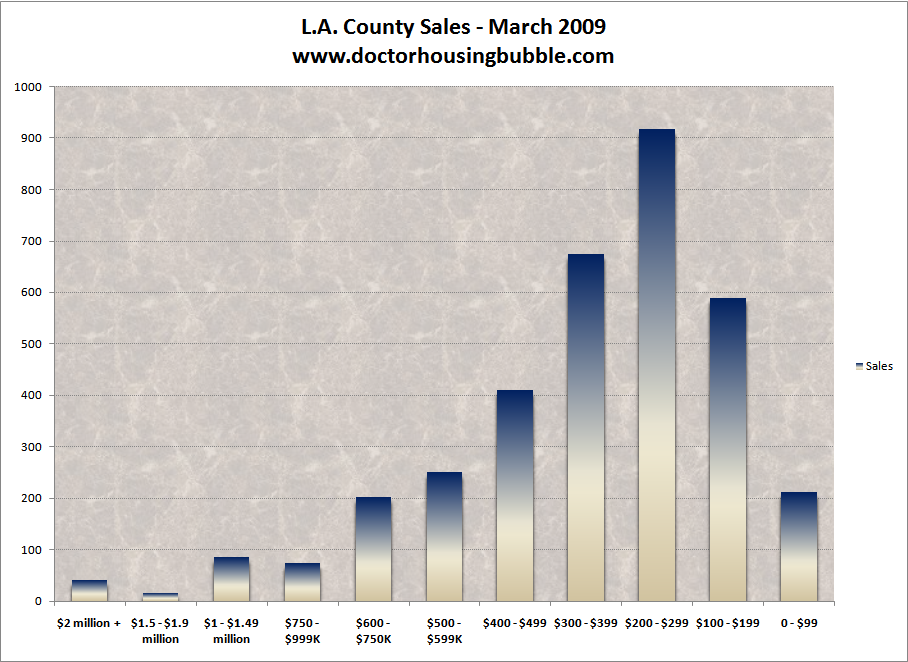
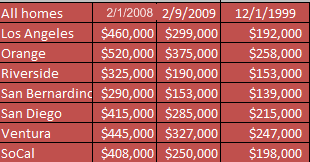
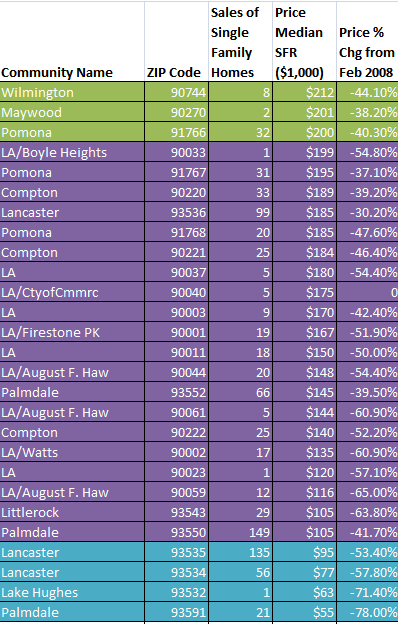
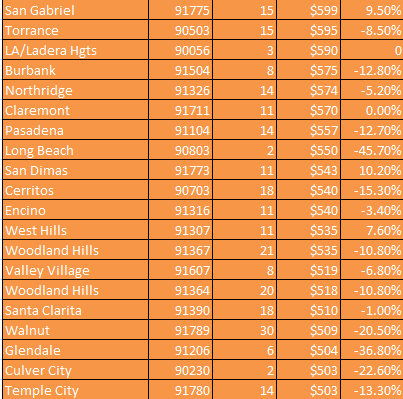
 Subscribe to feed
Subscribe to feed






16 Responses to “A City in L.A. County with a $55,000 Median Price? The Housing Market in Los Angeles County: Looking Deep into the Home Sales Data for 88 Cities. Lower Priced Areas Taking Brunt of Price Declines but Medium to Higher Priced Areas Stubborn in Price Movements.”
DHB, once again great work on your stats. I think the most important fact from your post is this..
1- Affordable housing has seen a bottom or is very near the bottom. In Utah the median house price is affordable. Prices have dropped and now home’s are at a point where they are selling.
2- Completely agree with the upper price ranged homes.. They will come down, and maybe even significantly more. Simply based on the fact of average income in our country.. Are there the elite few who can afford a home for several million dollars? Sure! but not that many. Affordable housing, is back.. It won’t go up.. It is going to stay consistent.level out. This is healthy for our country..
Nice post…
Great post DHB. I live in West LA and like you said, the prices in the higher-end areas are surprisingly and stubbornly holding up. Thanks for the detailed explanation and I am waiting for the eventual drop in prices here on the west side.
I also think there is a supply/demand dynamic going on in the market. I theorize that because sub-prime and near-prime hit first, those homeowners had to abandon ship first. This flooded the market in those price bands. The middle to near affluent owners probably have a bit more cushion and are doing everything in their power to stave off listing their home thus keeping the supply much tighter. With the alt-A and option-ARM wave getting ready to hit full force, I suspect we will see many more home get pushed out onto the market in these areas. When defaults start to rise and credit ratings get shot for these folks, there will be fewer who can qualify to buy at these upper levels. If the supply goes up and the demand goes down, guess where the price will go???
It would be helpful if Comrade Housing Bubble would be so kind as to provide year-over-year inventory levels to accompany his sales price data. The relative difference in inventory and its effect on price might help to explain what’s happened and what might happen next.
Be brave Comrades!
I live in the Washington DC area and I’ve noticed the exact opposite of what you’ve seen in SoCal. It seems like the more expensive homes, $700k+ have seen their asking prices drop a lot. Maybe 30-40%. Houses priced less than $600k have had small drops in asking price. Maybe 10%.
If you were in the market for say a $550k house, for $150k more you could get twice as nice of a home.
I don’t know why this is the case. My hypothesis is that since the government is such a big employer in the DC area, salaries are kind of capped on the up and down side. Plus the government is a fairly stable employer. What’s happening is typical government employee households make enough to qualify for a home up to $600k and these people have stable work. Those who make enough to buy a more expensive home tend to work in the private sector and their employment is much less stable. Hence they aren’t as interested in taking a risk on a new home.
Keep up the good work.
I just went house shopping in San Diego and had exactly the same experience with the $400-600k range homes. They seem to have not fallen more than 15% from the 2005 peaks, which is a sharp contrast to the rest of the market. Personally, I think it’s only a matter of time before these prices drop with the rest of the market.
Here in coronado ca. the prices have not moved down much. we are waiting on the sidelines (renting) hope you are right and the middle to upper will go down. many houses for sale but do not see many moving.
Can you please comment on the 75th percentile prices gaining for the last 3 months? How does this fit into your expectations?
Thanks, love the blog.
http://www.housingtracker.net/asking-prices/los-angeles-california
Another comment in San Diego. We’re looking to buy here, and have been renting for the last two-and-a-half years. We prefer North County (Inland), but prices have not fallen even a stone’s throw close to the other area we’re looking into: Chula Vista. We’re well priced into CV, but holding off IF we find that one perfect house in a good neighborhood.
Echo sanderson’s observation about not much moving in Coronado. Work on the island (the Navy base), and I see A LOT of for sale signs. Although it’s a premium location, some of the asking prices are absurd – even in light of the bubble which passed us by. Love to see this stalemate come to and end, if only to observe, not participate.
I live in the SF Bay Area and have noticed the same effect. Lower prices homes have dropped in price, but the higher priced homes have not. However, this is exactly the opposite of what happened during the last recession (the dot com bust in 2001). During that recession, lower priced homes did not fall in value, whereas the higher end dropped significantly. Perhaps higher priced homes are not dropping in value as much as lower priced homes since most of the job losses have occurred in poorer demographic groups such as retail and real estate?
@ Charlie
I was looking at condos around the DC area & noticed properties around Arlington County have dropped quite a bit from Crystal City to Balston despite being close to Metrorail. On the other hand, prices along highway 355 from Chevy Chase through Bethesda to Rockville in Montgomery County haven’t dropped at all.
There are condos in 2 buildings on Wisconsin & Woodmont Avenues in Bethesda that start around $900,000 & the buildings are each about 18-months old & no surprise there not selling.
It is fair to say that area is a reverse commute haven for red line Metrorail riders to there jobs in downtown Bethesda making that city more desirable, but by comparison most condos in Arlington don’t reach those prices. Even though you are just as close to the center of the district as you are from Bethesda by the Metrorail.
One more fly in the ointment if you look in Silver Spring the prices for condos are the lowest of all the close in cities, wich I find a bit strange because localities like Fairfax & Louden Counties wich are further out & currently don’t have Metrorail service unless they are in Springfield, Huntington or Vienna. This causes traffic jams along I-66 & I-95/495 just to get to the stations in those communities.
Here’s what may be happening to the high-end houses in California:
~
I’ve been watching a 7,000 SF McMansion in the Reno area that’s been on the market a long time. Last recorded sale was in 2004 for $1.2 million. Last August, they were asking $2.1 million. A couple of months ago, it was $1.8 million. Today, the asking price is $1.55 million “with assumable 1st and seller-financed 2nd. 3.25% for first year.”
~
I think that paints the picture pretty well.
Singhace,
I know plenty of architects, engineers & teachers all with degrees many of them with masters degrees (of course along with some property managers and some who work in the financial sector) who have lost their jobs. Some have been lucky to keep their jobs with a reduced salary. Most of my friends and family live in LA or OC. From my rough estimation about 20 – 25% of my friends and family have lost there jobs. I wish it was closer to only 10% !!
Sometimes the simplest answer is the most obvious.
I think there are just THAT many people with a lot of money, STILL, with enough to keep the upper houses in the same price range from sinking.
I still see millions going to work each day. The 405 and the 101 still is a nightmare, no signs of recession with the volume of traffic.
Many of these folks have high paying jobs and have not been hurt at all by the recession. Maybe some are on the sidelines waiting, or maybe some have owned their homes for many years. Before the bubble.
This bubble didn’t hit everyone. I venture to say a good percentage felt no pain at all. So it might just be that there are THAT MANY people out there with a ton of money to keep the upper-end sustained.
Re: 75th percentile question by VDog
Those are asking prices. It simply means more higher priced homes are coming on the market. Maybe people were waiting a couple of years before trying to sell their expensive home, or maybe they are finally feeling the strains of paying for an expensive home and now putting it on the market. Notice 3 years ago the 75% percentile was about $800k and now it’s $670k.
As the Dr has said many times, prices will keep falling until they go back to historical norms with wages.
I am a realtor in socal and I don’t believe prices are going to move downward by any significant amounts.
A couple of reasons–
1. Many first time home buyers have saved up their funds and have been waiting for the right time to wade into the market. Many of them were not able to get in the last go-round (lucky for them as it turns out), but they are determined to not miss the boat this time.
2.There are a tremendous number of investors with tons of money in the market. California is on sale, and investors are licking their chops and behaving like kids in a candy store. Cash is king, and the banks that own these properties love them. Many investors are quietly negotiating with various banks and buying up prime properties that will never hit the market.
Well priced houses in decent locations are attracting a minimum of five offers. I have clients that have great credit and have been offering $20 to $30k over asking price, and are still getting out bid! In my humble opinion, I think prices should fall a bit more, because they are still out of line with most incomes.
That being said, low interest rates, pent-up demand from renters, and the fact that regardless of an unemployment rate of 10.3 %, there are still 89.7% of Californians employed somewhere, mid-range houses will continue to move at a pretty good pace. If you want to prove this, just ask anyone you know who is actively seeking to buy a home in a desirable area how their search is going and how many offers they have had rejected. Low ball offers need not apply.
Last, to those market observers that say they see so many for sale signs, those are most likely short sales that have not yet been approved. In most areas, if you took the short sales off of the market, the supply would shrink dramatically and it would truly be a seller’s market, which in some areas, it already is.
socalrealtor
I tend to agree with your assesment that it is a “sellers” market in many of the decent areas, at least in San Diego.
My only question is, don’t you think the government is responsible for that? After all, it is trying with all of its might to reflate the bubble.
Forclosure modifications
Sub 5.75 interest rates are due to the Fed
10,000 credits from Ca.
8000 credits from the Feds
And on and on and on.
What happens when it all ends?
Leave a Reply